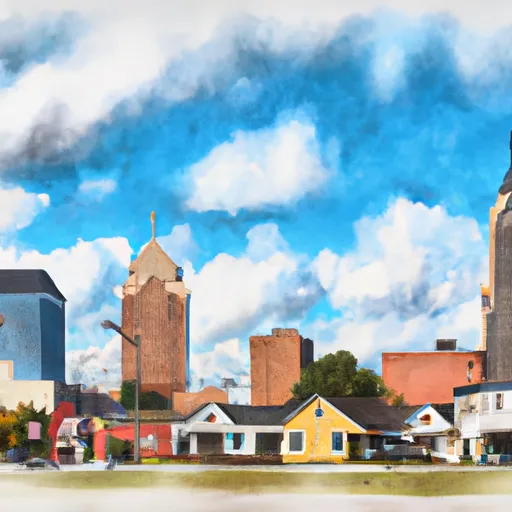-
 Snoflo Premium
Snoflo Premium
Get unlimited access to all our content
With no Ad interruptions! - Start Your Free Trial Login with existing account
Oakland-City
Eden Index
Climate
8.1
•
Recreation
3.7
•
Community
1.9
•
Safeguard
5.0/10

Oakland City is a charming town located in Gibson County, Indiana. The climate in Oakland City is typically characterized by warm summers and cool winters. The area experiences moderate rainfall throughout the year.
Hydrologically, Oakland City is situated near the Patoka River, which provides beautiful scenic views and opportunities for fishing and boating. The region also features several small lakes and ponds, perfect for recreational activities such as kayaking and paddleboarding.
Outdoor enthusiasts can explore the Oakland City Conservation Club, which offers various recreational opportunities like hunting, fishing, and camping. The nearby Gibson County Park provides nature trails for hiking and bird-watching. Additionally, the Oakland City Golf Club offers a challenging course for golf enthusiasts.
Overall, Oakland City, Indiana, offers a pleasant climate, scenic hydrology constituents, and diverse outdoor recreation opportunities for individuals seeking an active and nature-filled getaway.
What is the Eden Index?
The Snoflo Eden Index serves as a comprehensive rating system for regions, evaluating their desirability through a holistic assessment of climate health, outdoor recreation opportunities, and natural disaster risk, acknowledging the profound impact of these factors on livability and well-being.
Climate Health Indicator (CHI): 8.1
Oakland-City receives approximately
1202mm of rain per year,
with humidity levels near 81%
and air temperatures averaging around
13°C.
Oakland-City has a plant hardyness factor of
6, meaning
plants and agriculture in this region thrive during a short period during spring and early summer. Most
plants will die off during the colder winter months.
By considering the ideal temperature range, reliable water supplies, clean air, and stable seasonal rain or snowpacks, the Climate Health Indicator (CHI) underscores the significance of a healthy climate as the foundation for quality living.
A healthy climate is paramount for ensuring a high quality of life and livability in a region, fostering both physical well-being and environmental harmony. This can be characterized by ideal temperatures, reliable access to water supplies, clean air, and consistent seasonal rain or snowpacks.
Weather Forecast
Streamflow Conditions
Patoka-White
Area Rivers
Patoka-White
Snowpack Depths
Patoka-White
Reservoir Storage Capacity
Patoka-White
Groundwater Levels
Recreational Opportunity Index (ROI): 3.7
The Recreational Opportunity Index (ROI) recognizes the value of outdoor recreational options, such as parks, hiking trails, camping sites, and fishing spots, while acknowledging that climate plays a pivotal role in ensuring the comfort and consistency of these experiences.
Access to outdoor recreational opportunities, encompassing activities such as parks, hiking, camping, and fishing, is crucial for overall well-being, and the climate plays a pivotal role in enabling and enhancing these experiences, ensuring that individuals can engage in nature-based activities comfortably and consistently.
Camping Areas
| Campground | Campsites | Reservations | Toilets | Showers | Elevation |
|---|---|---|---|---|---|
| Greene - Sullivan State Forest | None | 521 ft | |||
| Montgomery Bell State Park | 80 | 618 ft | |||
| Sullivan County Park | 450 | 520 ft | |||
| Joe Wheeler State Park | 116 | 573 ft | |||
| Sunset City Park | None | 548 ft | |||
| Meriwether Lewis | 32 | 963 ft | |||
| David Crockett State Park | 107 | 947 ft | |||
| Destiny Parks Military - Fort Campbell | None | 544 ft | |||
| Res 26 - Greene - Sullivan State Forest | 25 | 498 ft | |||
| Harpeth River Bridge | None | 393 ft |
Nearby Ski Areas
Catastrophe Safeguard Index (CSI):
The Catastrophe Safeguard Index (CSI) recognizes that natural disaster risk, encompassing floods, fires, hurricanes, and tornadoes, can drastically affect safety and the overall appeal of an area.
The level of natural disaster risk in a region significantly affects safety and the overall livability, with climate change amplifying these risks by potentially increasing the frequency and intensity of events like floods, fires, hurricanes, and tornadoes, thereby posing substantial challenges to community resilience and well-being.
Community Resilience Indicator (CRI): 1.9
The Community Resilience Indicator (CRI) recognizes that education, healthcare, and socioeconomics are crucial to the well-being of a region. The CRI acknowledges the profound impact of these elements on residents' overall quality of life. By evaluating educational resources, healthcare accessibility, and economic inclusivity, the index captures the essential aspects that contribute to a thriving community, fostering resident satisfaction, equity, and social cohesion.

